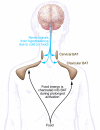Yes, even human brown fat is on fire!
- PMID: 22269320
- PMCID: PMC3266796
- DOI: 10.1172/JCI60941
Yes, even human brown fat is on fire!
Abstract
That adult humans possess brown fat is now accepted - but is the brown fat metabolically active? Does human brown fat actually combust fat to release heat? In this issue of the JCI, Ouellet et al. demonstrate that metabolism in brown fat really is increased when adult humans are exposed to cold. This boosts the possibility that calorie combustion in brown fat may be of significance for our metabolism and, correspondingly, that the absence of brown fat may increase our proneness to obesity - provided that brown fat becomes activated not only by cold but also through food-related stimuli.
Figures


Comment on
-
Brown adipose tissue oxidative metabolism contributes to energy expenditure during acute cold exposure in humans.J Clin Invest. 2012 Feb;122(2):545-52. doi: 10.1172/JCI60433. Epub 2012 Jan 24. J Clin Invest. 2012. PMID: 22269323 Free PMC article.
References
-
- Barrington SF, Maisey MN. Skeletal muscle uptake of fluorine-18-FDG: effect of oral diazepam. J Nucl Med. 1996;37(7):1127–1129. - PubMed
Publication types
MeSH terms
LinkOut - more resources
Full Text Sources
Other Literature Sources

